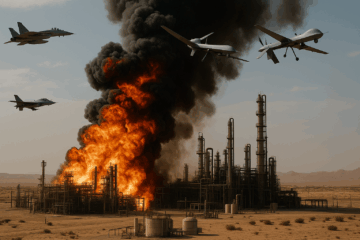Recent action by the United States and like-minded nations to defend Israel from an unprecedented Iranian airstrike demonstrates how the United States and NATO can defend their allies and partners against similar air threats. With a 99 percent success rate in downing Iranian ballistic missiles, cruise missiles, and long-range attack drones, this should serve as an indicator of how NATO can support the defense of Ukrainian critical infrastructure, for example. The use of a diverse mix of air defense ships and aircraft, as part of providing an advanced integrated air and missile defense shield for Israel, offers valuable lessons for future endeavors.
The lessons from this experience are numerous. First, American and coalition air defenses performed marvelously in the political act of coordinating multiple nations in the defense of Israel. This required working out the logistical issues prior to taking a defensive posture ahead of time.
Second, the response proved the maturity of ballistic missile defenses. Israel’s Iron Dome (and other defenses), American SM-3s, and coalition systems were excellent. It was a practical demonstration of the technical improvements in air and missile defenses.
Third, the response was a demonstration of successful intelligence integration. Coordinating intelligence among coalition partners is never easy, but as the coalition response proved, it is possible.
Fourth, coalition members took full advantage of the geography and time provided by Iranian air strike. With the coalition expecting a response, they had the time needed to prepare for an attack. Moreover, due to the distances the cruise missiles and drones had to traverse, coalition defenders could best posture themselves at the optimal locations to intercept inbound weapons.
However, there are also negative lessons to learn from the coalition’s response to Iran’s attack. First, the response was expensive. At least $1 billion was spent to defend Israel from Iranian and Houthi attacks. Israel spent half a billion dollars to defend against this single attack. Such expenditures are unsustainable. While this captures the immediate costs, more time is needed to determine the long-term/opportunity costs.
Second, the United States is continuing to deplete limited stocks of expensive and exquisite missile systems against relatively cheaper Iranian weapons. The US and coalition must reverse this exhaustion strategy.
The variation in responses to Russia’s invasion of Ukraine and Iran’s attack on Israel certainly create difficult political questions. Taiwan, for example, may look at its own situation and see this varied response as politically problematic for itself. Fears of escalation against a nuclear power are logical, but to defeat any of these nations equates to extinction. Defending these democratic nations’ right to exist is in the United States’ and NATO’s interest.
The United States does not, however, have the luxury of time in preparing for future Russian or Chinese attacks on Ukraine or Taiwan. Any attack will also see far more sophisticated weaponry than that employed by Iran. Thus, defending Ukraine and Taiwan requires persistent forces ready to defend these nations.
If the United States, NATO, and other American allies are committed to defending democracies like Ukraine and Taiwan, there are three moves the United States should make. First, it must take proactive and deliberate actions. It could include establishing defensive zones around critical infrastructure and civilian population centers. This includes combined land- and sea-based defenses for shooting down air attacks. The goal is to protect civilians and critical infrastructure against indiscriminate attacks.
Second, the United States should accelerate investments in inexpensive weapon systems. Providing more inexpensive air defenses allows for sustained defense. Focusing on capabilities that disrupt adversary surveillance, reconnaissance, and targeting systems along with electronic warfare effort should serve as a central focus. The US and NATO must counter the exhaustion strategy employed by Russia, China, and Iran.
Third, the United States and its allies should enhance their partnership by further exchanging lessons learned, innovative ideas, and best practices for defending against evolving attacks. Reducing bureaucratic obstacles that limit ally and partner access to critical air defenses is part of that effort.
The reasons for doing this are simple and best summarized in four points. First, it is important to improve American credibility. Nothing will aid American deterrence efforts more. There is ample reason to argue that Ukraine and Taiwan should receive the same support as Israel. All are fighting for their nations as enemies vow to destroy them. Thus, the US and NATO must do more to protect democratic nations.
Second, for the sake of deterrence, demonstrating to adversaries that the United States will not allow air strikes on democratic nations is important. Establishing protective cover with American and NATO forces can act as a deterrent that drives tensions down. The “responsibility to protect” concept is useful in deterring Russia, China, and/or Iran from attacking the infrastructure and citizenry of democratic states. There is always a risk of escalation by intervening, however. The risk of defeat and the elimination of democratic states by authoritarian regimes would, however, do irreparable harm to the United States’ standing in the world.
Third, there is value in creating and enforcing international norms. Even though Russia and China would veto any UN Security Council resolution supporting the defense of Ukraine or Taiwan, establishing such norms is worth the effort.
Fourth, the United States must defend democracy and freedom. Many nations are looking at both Western democracies and Eastern authoritarians to determine which path to follow. It is in the United States’ interest for them to take the democratic path.
It is time for the West to take a stand. While Americans may not seek war, authoritarian adversaries often believe that war is their best option for reshaping the world in their own image. The United States and some NATO member states demonstrated the means and will to defend Israel against Iranian air attack. Providing a similar defense to Ukraine and Taiwan certainly deserves further consideration if the United States aspires to continue leading the free world. Abrogating that position would be a mistake. It is now time for the US and NATO to take more risks in supporting friends in their hour of need.
CDR (Ret.) Todd Clawson is a Fellow at the National Institute for Deterrence Studies. Opinions expressed are the author’s own and not those of the Department of Defense or the Department of the Navy.




